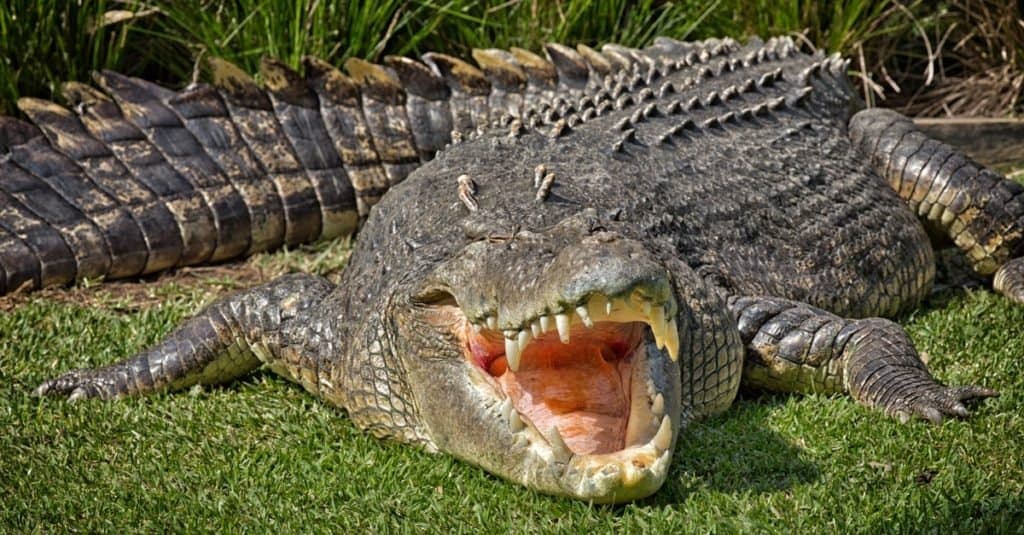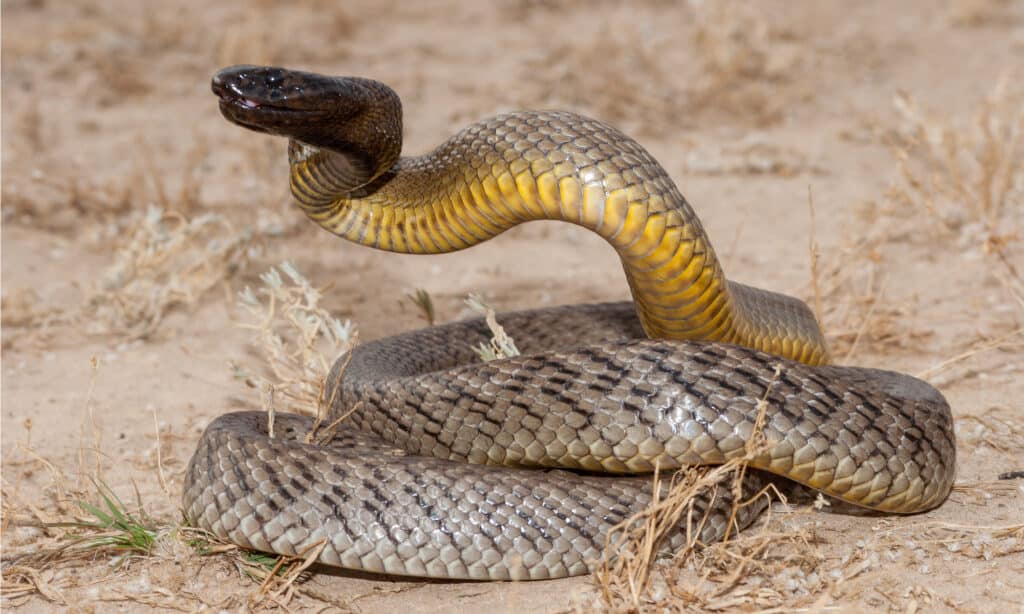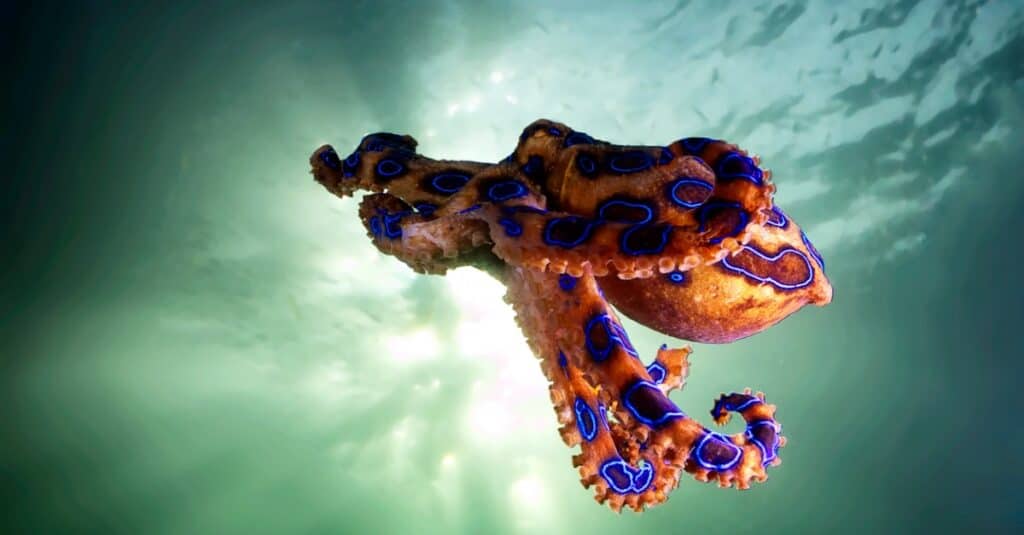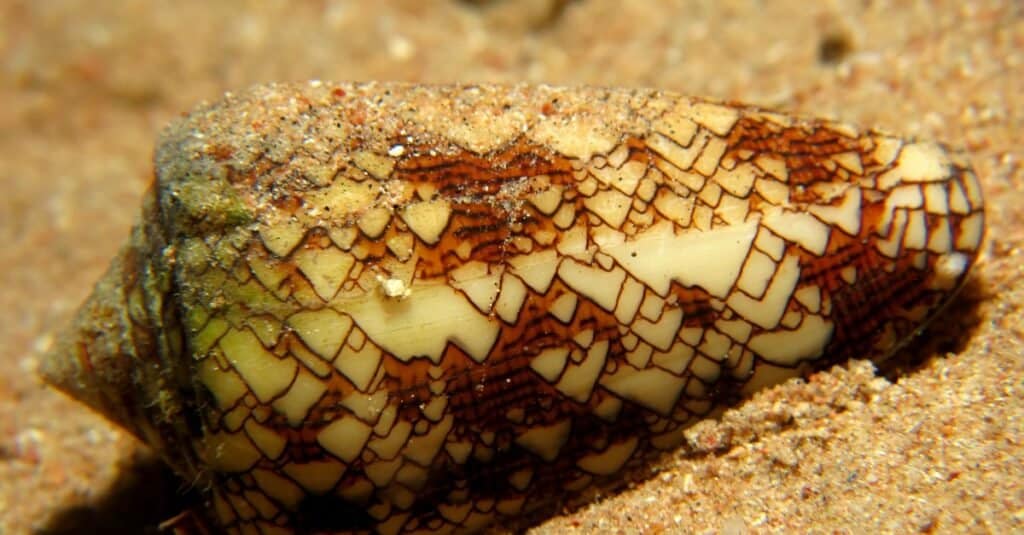Australia has long been known as the home of some of the most dangerous creatures on the planet. Although somewhat true, Australia is safer than you think. There have been fewer deaths over the last century, thanks to increased availability of anti-venom. However, for your convenience, we have identified the top five deadliest animals you should be on the lookout for in Australia. This list may assist you in avoiding attacks. Let’s study these animals!

1. Saltwater Crocodile

Saltwater crocodiles have the world’s strongest bite.
©PomInOz/Shutterstock.com
The fierce saltwater crocodile is found in saltwater environments and brackish wetlands. They can be discovered from India’s east coast to northern Australia and Micronesia. The saltwater crocodile is the world’s largest reptile, reaching lengths of over 23 feet (6.5 m) and weighing over 2,200 pounds (1,000 kg). A crocodile this big can eat almost anything that gets too close, although saltwater crocodiles specialize in drowning terrestrial species like birds and mammals. Saltwater crocodiles reside in brackish (low salinity) waters near the shore.
The majority of crocodile species are harmless and would rather avoid people than confront them. Saltwater crocodiles, however, are aggressive towards people and are responsible for at least several dozen assaults each year. The saltwater crocodile has the world’s strongest bite. Its powerful teeth can reach 5 inches (13 cm). These two traits, along with the animal’s capacity to hold its breath for long durations, make it an ideal predator for large land mammals.
2. Inland Taipan

Inland taipans are the most venomous snakes in the world, not just in Australia.
©Ken Griffiths/Shutterstock.com
The inland taipan (Oxyuranus microlepidotus), often known as the small-scaled snake or the fierce snake, is a venomous snake in the Elapidae family. It is only in semi-arid areas of Eastern Australia. The local Aboriginals called the snake dandarabilla. It is Australia’s most venomous snake. Inland taipans are nervous snakes that will attack if disturbed.
To defend itself, the inland taipan strikes with its head and forebody lifted. To give its head a larger look, it inflates and compresses its body laterally (rather than dorso-ventrally as other species do). The snake will always strike, frequently without warning, with many snapping bites. This fast-attacking snake hurls itself forward or sideways and reaches high off the ground. The snake can bite a human numerous times before the person realizes the snake is even there.
3. Blue-Ringed Octopus

Blue-ringed octopi are not aggressive but will defend themselves when threatened or handled.
©iStock.com/Subaqueosshutterbug
The blue-lined octopus is the most common blue-ringed octopus in Sydney. The species are all brown, with bright blue patterns revealed only when disturbed. Blue-lined octopi inhabit rocky intertidal shores and coastal waters. These little cephalopods are related to other octopi species, squid, cuttlefish, and nautilus. Blue-ringed octopi are venomous aquatic animals. The brilliant blue rings on these little octopi make them easy to identify. They serve as a warning to predators.
These octopi hunt for food on the seafloor like most other octopi. They seek rocky nooks and similar terrains to build their dens, so they adore coral reefs and tide pools. These species reside in shallow waters. Despite their bright colors, they are great at camouflaging themselves.
Aside from the occasional inexperienced diver, blue-ringed octopi rarely bite. They are not aggressive but will defend themselves if handled. Most blue-ringed octopi are invisible. They prefer to hide than battle a predator.
4. Textile Cone Snail

Textile cone snails use their teeth to inject prey with their lethal venom.
©iStock.com/lilithlita
Remarkable textile cone snails are among the most venomous animals you will find. These snail species grab their prey using harpoon-like hollow teeth (radula) that they rapidly insert into their victim to inject lethal venom.
Human attacks are initiated when a cone snail is walked on in the ocean or picked up from the sea or beach. One Australian youngster came dangerously close to death after picking up a live snail, believing it was only the shell. The story went viral, with the moral being to avoid these shells entirely.
5. Great White Shark

The incredible great white shark has a bite force of 18,000 Newtons.
©Martin Prochazkacz/Shutterstock.com
Great white sharks account for more than a third of all shark attacks each year. The great white shark (Carcharodon carcharias) is commonly known as the white shark, white pointer, or simply great white. It is a large mackerel shark species living in all major oceans’ coastal surface waters, most notably off the coast of Australia.
Great white sharks have a bite force of 18,000 Newtons, making them one of the most powerful biters known to man. These apex predators do not intend to hurt humans, yet attacks occur regularly due to their poor vision, which misidentifies us as other marine mammals such as seals. If you ever see one, we recommend making a hasty exit.
Wrapping Up
This list demonstrates that even the tiniest predators can be far more dangerous than you’d think. Keep in mind that this list of deadliest animals in Australia indicates various types of lethal animals found in the region but is by no means exhaustive.
Summary of the Top 5 Deadliest Animals in Australia
| Rank | Species | Habitat | Risk Factor | Aggressive |
|---|---|---|---|---|
| 1 | Saltwater Crocodile | Brackish (low salinity) waters near the shore | The world’s strongest bite | Yes |
| 2 | Inland Taipan | Semi-arid regions | The world’s most venomous bite | Yes |
| 3 | Blue-Ringed Octopus | Coral reefs and tide pools | An extremely dangerous form of venomous marine life | No |
| 4 | Textile Cone Snail | Shorelines or marine water | Lethal venom transmitted through biting | No |
| 5 | Great White Shark | Coastal waters | A powerful bite force of 18,000 Newtons | No |
The photo featured at the top of this post is © Keitma/Shutterstock.com
Thank you for reading! Have some feedback for us? Contact the AZ Animals editorial team.






